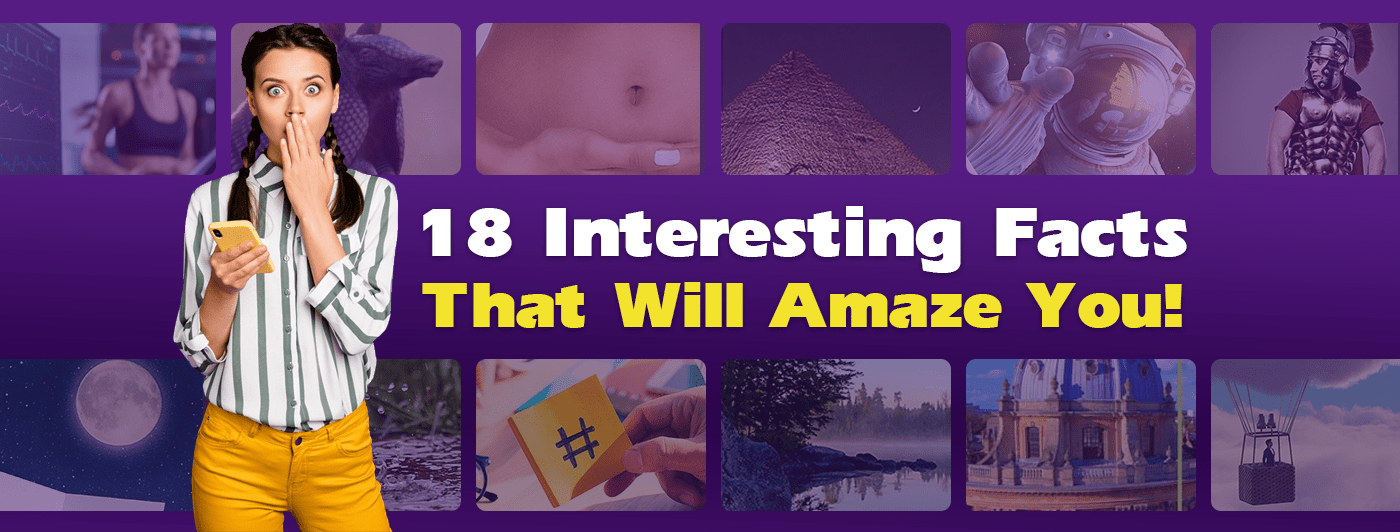Buckle up if you’re looking for facts to wow your friends. We’ve scoured the Internet and found some of the most interesting facts that we think will shock even the most knowledgeable person.
For example, did you know that there are 13 months in Ethiopia and the Ethiopian calendar is seven years and eight months behind the Western calendar? For more such interesting facts, read on!
1. 1816 was known as “the year without a summer.”
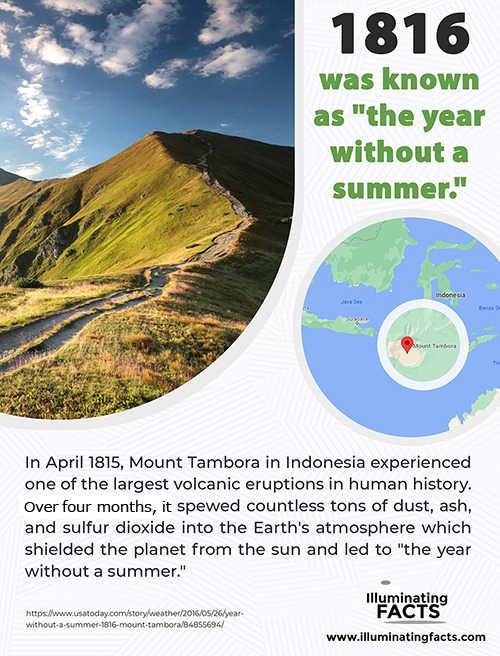
1815 became the year without summer for millions of people in parts of Europe and North America. It was due to the largest volcanic eruption in human history. For over four months, Mount Tambora in Indonesia spat out millions of tons of sulfur dioxide, ash, and dust.
It was 100 times more powerful than the eruption of Mount St. Helens in 1980. As a result, the temperature in the affected areas was as low as 3 degrees causing widespread migration, epidemics, and food shortages. [1]
2. Americans thought tomatoes were poisonous until the early 19th century. They were deemed “poison apples.”
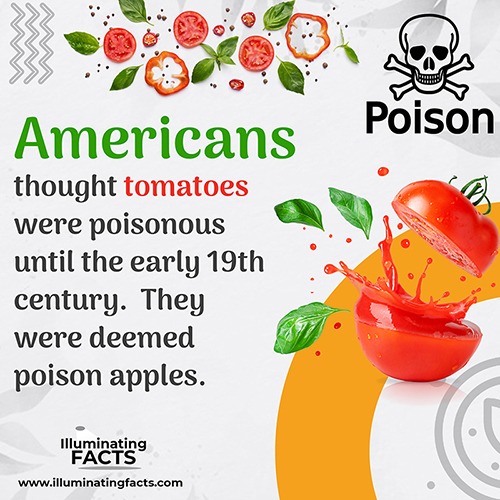
There was a large percentage of Europeans who feared tomatoes till the late 1700s. It was given the name poison apple because aristocrats were dying after eating them. The high lead content in the fruit was the cause of death which came from pewter plates that many wealthy Europeans used.
Even as tomatoes became more common in recipes, another problem occurred. An outbreak of the Green Tomato Worm with four inches in length and a horn at its back created a myth about tomatoes. People began to believe the worm’s spittle was as poisonous as a rattlesnake, and if it made contact with skin, the person could die in a few hours. [2]
3. Armadillos almost always give birth to identical quadruplets.

In Latin America, there are over 20 varieties of the armadillo. In the United States, there are only nine-banded armadillos. They are the only mammals to have shells. Also, not all armadillos can encase themselves, but only the three-banded armadillos are capable of curling their back feet and head. As a result, they become like a hardball.
Female Armadillos almost always give birth to quadruplets. It happens due to a process known as polyembryony. In this process, one fertilized egg can develop four genetically identical pups. Usually, the egg divides into four or sometimes five to six pups. [3]
4. From 60 belly buttons, scientists found 2,368 bacterial species, and nearly 1,500 of them may be new to science

Scientists studied belly buttons and found an amazing 2,368 bacterial species, and nearly 1,500 of them may have never been previously discovered. Some belly buttons harbored only 29 species, but some had 107. 92% of the types of bacteria appeared in less than 10% of the subjects. Some subjects showed most of the bacteria species.
With all these types of bacteria in the belly button, scientists or researchers dubbed the belly button a “rainforest for bacteria.” [4]
5. Cleopatra, the famous ruler of Egypt, actually lived closer to the moon landing than to the construction of the Great Pyramid of Giza. The queen died in 30 B.C., while the great pyramid of Giza was built around 2560. The pyramid was completed more than 2,500 years before Cleopatra’s time.
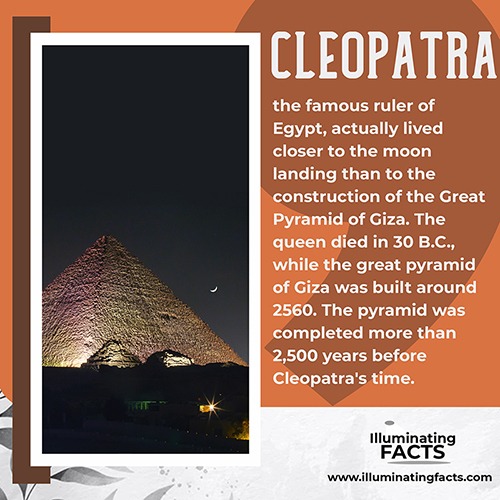
The Great Pyramid of Giza was built over a period of 20 years and was completed around 2560 BC. However, Cleopatra VII was the last active ruler of the Ptolemaic Kingdom of Egypt. She was born in 69 BC, which was 2,491 years after the completion of the Great Pyramid of Giza. Neil Armstrong walked on the moon in 1969, which happened 2,038 years after the birth of Cleopatra VII.
6. In space, you can “cold weld” two pieces of the same type of metal simply by touching them. They will bond and be permanently stuck together (note the pieces can not have any coatings, oxidation, etc.).
The atoms of the individual pieces of metal have no way of knowing that they are different pieces of metal, so the lumps join together.
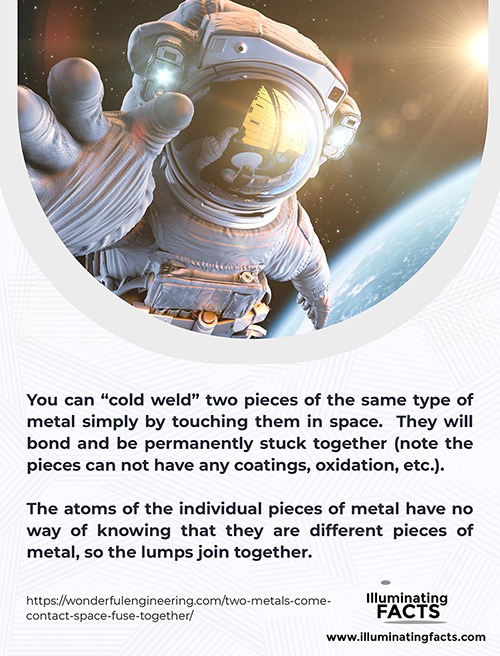
When flat and clean surfaces of two metals come into contact in a vacuum state, they fuse or are “welded together” without melting. This type of welding is known as “cold welding.” During the Gemini IV mission, astronaut Ed White noticed that the capsule hatch was not closing. His fellow astronauts concluded that the metals might have been attached through cold welding because of the oxidation layer on the metal parts. [5]
7. Ancient Greeks and Romans thought crocodile dung had beautifying and restorative properties. The dung was mixed with mud for anti-aging purposes and bathing.
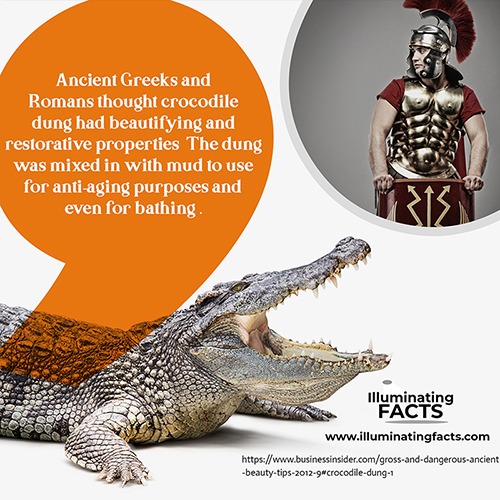
Beautification and makeup have been a treatment since ancient Egyptians and Greeks. Today, we peel, pinch, and inject ourselves with beautification, but thousands of years ago, people used disgusting and dangerous things to beautify themselves and be perfect.
The ancient Greeks and Romans believed that crocodile dung had restorative and beautifying properties. The manure was mixed with mud for relaxing baths and anti-aging facials. Still, mud baths are popular today. They are believed to relieve joint and muscle pain, improve skin tone and flush toxins from the body. [6]
8. Did you know that in Ethiopia:
- A year lasts 13 months.
- The Ethiopian calendar is also seven years and eight months behind the Western calendar.
- Ethiopians calculate the birth year of Jesus Christ differently. When the Catholic Church amended its calculation in 500 AD, the Ethiopian Orthodox Church did not.
- In Ethiopia, there are 12 months, and each has 30 days but the 13th month in the Ethiopian calendar can have five or six days. It depends on the leap year.
- In Ethiopia, time calculation is also different. Each day is divided into two 12-hour slots. The day starts at 06:00. Their midnight is at 18:00. [7]
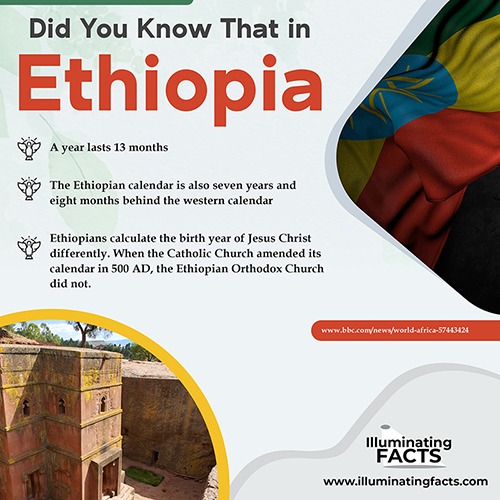
9. The hashtag (#) symbol is technically called an octothorpe. With “Octo” referencing the 8 points.
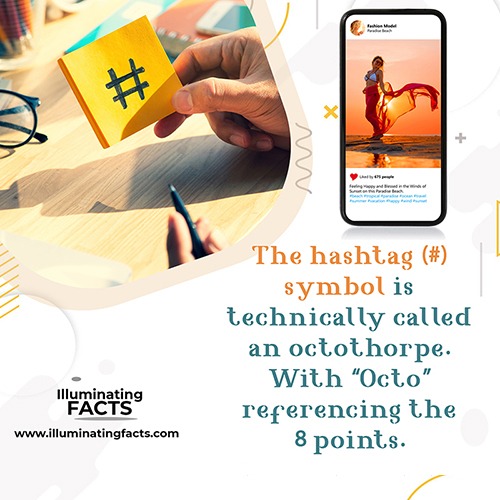
The hashtag is known by many names such as pound sign, number sign, and hash mark. The hashtag has become a famous symbol on most social media sites but no one knows its origin. It is believed that the telecommunications industry adopted the word Octothorpe when keypads were introduced in the 1960s. No one knows how the hashtag got the name of octothorpe. Octo means eight points, but Thorpe is still mysterious.
10. If all of the water fell on Earth at once, the whole planet would get about 1 inch of rain
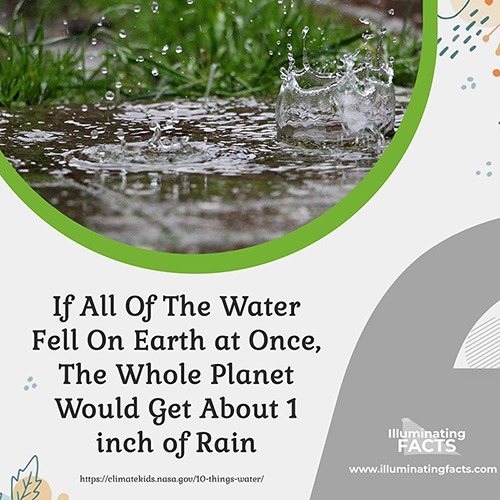
96.5% of the water on the Earth is found in our oceans. It covers 71% of the planet’s surface. At any given time, about 0.001% is floating in the atmosphere above us. If all of this proportion of water fell on Earth’s surface as rain, the entire plant would receive about 1 inch of rain. [8]
11. If you fold a standard piece of paper 42 times, it would be thick enough to reach the moon.

In reality its hard to fold a piece of paper in half more than about eight times. Theoretically, you could keep folding a piece of paper in half. In fact, if you fold a standard piece of paper 103 times, the thickness of the paper will be greater than the observable universe, which is 93 billion light-years.
With exponential growth, you can make a 0.0039-inch-thick paper as thick as the universe. If you fold it perfectly in half, you can double its thickness. With 42 folds, you can reach the moon. [11]
- 10 folds = width of a hand.
- 23 folds = 1 kilometers = 3,280 feet.
- 30 folds = 100 kilometers high
- 42 folds = Moon
- 51 folds = Sun
12. Minnesota actually has more shoreline than California or Florida
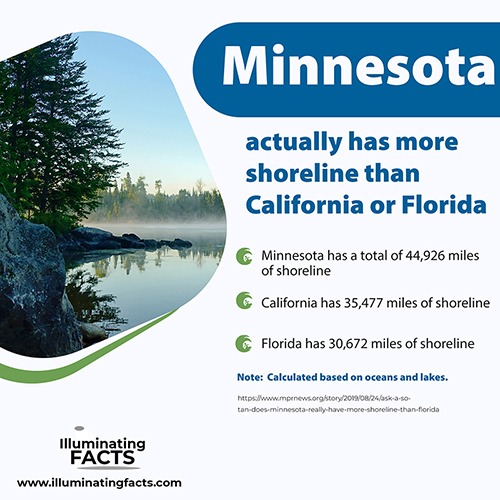
You might think that Florida, with many lakes and beaches, has more shorelines than Minnesota. It does not. In fact but Minnesota has more shorelines than Florida and Hawaii.[10]
- Minnesota has a total of 44,926 miles of shoreline
- California has 35,477 miles of shoreline
- Florida has 30,672 miles of shoreline
13. Mountain Dew was originally slang for mountain brewed moonshine.

Originally, the phrase “Mountain Dew” was slang for mountain-brewed moonshine. The origin of the name of the popular citrus-based soft drink, Mountain Dew, is believed to be rooted in the whiskey chaser (a drink that you consume immediately after having a shot of whiskey) invented by its founders, the Hartman brothers. In 2015, Mountain Dew — now a subsidiary of PepsiCo — sparked nostalgia among consumers by launching “DEWshine”.[16]
14. Oxford University is older than the Aztecs.
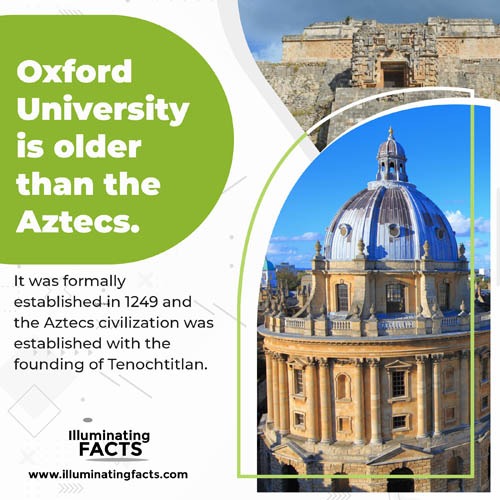
Oxford was founded for teaching in 1096 but was formally established as a full-fledged university in 1249. The Aztec empire, on the other hand, was found to be established in 1325. The research was done by archeologists based on the ruins of Aztec in the city of Tenochtitlan by Lake Texcoco.
15. The average cloud weighs an estimated 1.1 million pounds.

A cloud might seem like cotton candy that floats above us in the earth’s atmosphere. It is not true. A cloud consists of water droplets that can make it weigh around 500,000 kilograms or 1.1 million pounds. By this weight, you might wonder why it stays in the sky and does not fall on the ground. It is because the air below it is even heavier. Also, a lesser-density cloud floats on the dryer and denser air. [12]
16. The human heart beats 2.5 billion times in the average lifetime.
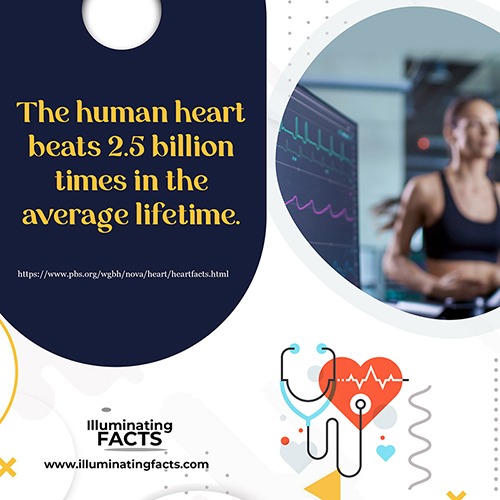
As a kid, the resting pulse can range from 90 to 120 beats per minute. An adult’s average resting pulse rate can be 72 beats per minute. In one day, your heart beats 100,000 times. Over a year, it can beat 35 million times. During an average lifetime, an average heart pumps the equivalent of 1 million barrels of blood. It is enough to fill about 3 supertankers. [13]
17. The Human Nose Can Detect More Than a Trillion Smells

A log on the fire, a cup of fresh coffee, a rose, or a cologne, are just four of the nearly 1 trillion smells a human nose and brain can distinguish from each other. According to a study, a human can smell about 10,000 odors. A combination of 128 odors can be differentiated by an average human nose and brain, which makes 1 trillion smells. [14]
18. Your mouth produces about one liter of saliva a day.

The saliva in your mouth not only fights infections in the mouth but also keeps the mouth and teeth clean. Your mouth produces around 1 to 2 liters of saliva each day. When you smell the aroma of delicious food, the production of saliva increases in advance for digestion. [15]
Conclusion
From a historical angle, it is great to have lists of interesting facts that can be shared in casual conversation or to know that they are out there. By showing curious people some of these facts and a little of their history, you can learn something new and, in turn, teach those around you without even realizing it. And these fun tidbits about our world will definitely impress your friends, so you might as well get them down now.
References
1. https://www.usatoday.com/story/weather/2016/05/26/year-without-a-summer-1816-mount-tambora/84855694/
2. https://www.smithsonianmag.com/arts-culture/why-the-tomato-was-feared-in-europe-for-more-than-200-years-863735/
3. https://www.nationalgeographic.com/animals/mammals/facts/armadillos
4. https://www.nationalgeographic.com/science/article/121114-belly-button-bacteria-science-health-dunn
5. https://wonderfulengineering.com/two-metals-come-contact-space-fuse-together/
6. https://www.businessinsider.com/gross-and-dangerous-ancient-beauty-tips-2012-9#crocodile-dung-1
7. https://www.bbc.com/news/world-africa-57443424
8. https://climatekids.nasa.gov/10-things-water/
10. https://www.mprnews.org/story/2019/08/24/ask-a-sotan-does-minnesota-really-have-more-shoreline-than-florida
11. https://gizmodo.com/if-you-fold-a-paper-in-half-103-times-it-will-be-as-thi-1607632639 /
12. https://www.usgs.gov/special-topics/water-science-school/science/atmosphere-and-water-cycle?qt-science_center_objects=0#qt-science_center_objects
13. https://www.pbs.org/wgbh/nova/heart/heartfacts.html
14. https://www.science.org/content/article/human-nose-can-detect-trillion-smells-rev2
15. https://www.natgeokids.com/nz/discover/science/general-science/15-facts-about-the-human-body/?awc=19533_1639838305_0a7bfa235aba6a9d55d4142b320eaf3f
16. https://www.smithsonianmag.com/smart-news/mountain-dew-had-ties-moonshine-once-upon-time-180957978/
